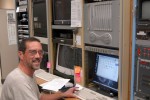The LTER Network Office (LNO) had an extraordinarily busy year, caused in part by the triennial All Scientists Meeting in Estes Park (see lead story) and the myriad activities associated with the LTER planning project. The involvement of LNO staff in the many emerging national research networks also kept us hopping. I mention a few of the high points below.
Members of the Network Office staff participated in multiple aspects of the LTER planning activity. I worked with the Science Task Force to plan and implement various stages of the planning process. I also was a member of the Governance Team that successfully devised revisions to the governance of the LTER Network. As members of the LTER Cyberinfrastructure (CI) Core team, John Vande Castle and James Brunt worked on the development of the LTER CI strategic plan. Mark Servilla of the LNO also contributed to this document.
The LNO acquired $80,000 through a proposal to NSF which, combined with $50,000 already available, provided funds to facilitate the further development of scientific ideas and collaborations arising from the ASM. Results from the review of proposals are not yet available, but we anticipate funding approximately 20 proposals.
Staff of the LNO facilitated 66 meetings, working groups, and trainings involving 1503 individuals. These meetings focused on research, education, administration, and planning for the LTER Network. In particular, the LNO supported the LTER Planning Grant by providing logistical assistance for a wide variety of planning grant meetings.
With changes in LTER governance and the need for more frequent interaction between LTER scientists, the LNO, in collaboration with Office of Research and Media Technology Services at the University of New Mexico, acquired, tested, and deployed a Polycom MGC-50+ video-teleconferencing bridge that can host multiple simultaneous meetings up to a maximum of 48 endpoint connections.
Interactions with outside experts brought in for the CI planning activities resulted in the implementation of LTER data searches directly through the Oak Ridge National Laboratory Distributed Active Archive Center’s (ORNL DAAC) “Mercury”-based search system. More information on this can be found in the ORNL Newsletter at http://www-eosdis.ornl.gov/news/lter_mercury_news.html.
Major advances have been made this year in the design and development of the Network Information System. A framework to support ecological synthesis has been developed by the Network Information Systems (NIS) team building on successful deployment of ecological metadata language (EML), the Metacat repository, and the Metacat Harvester. This framework, code-named PASTA, is efficient because it builds on existing investments and experiences, integrative because it adopts standard interfaces and approaches, and innovative because it incorporates data provenance and data quality into the design. Deployment and operation of the Metadata/Data Catalog has resulted in the registration of nearly 25,000 metadata documents, over 5,500 of which are from the LTER Network. The Metacat Harvester automatically harvests EML documents from 22 of 26 LTER Network sites. We have submitted proposals this year to the NSF Biological Databases and Informatics (BDI) program and OCI-SDCI to continue this work.
Finally, the LTER Executive Board has approved my request for a series of short research sabbaticals. After nine years as Executive Director of the LNO, these breaks will allow me to reconnect with LTER site research and refresh my intellectual curiosity. The first of these breaks will take place from December 1, 2006 until the end of February 2007. During my absence, James Brunt will be acting Executive Director.

 Enlarge this image
Enlarge this image